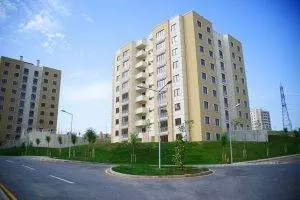The best investment option currently available appears to be real estate.
If done right, it offers the possibility of excellent returns, passive income, much-needed tax savings, and concrete capital protection.

Naturally, not all real estate is doing equally well. Some segments of the market continue to grow by 40% or more yearly. Some appear to be losing ground. Location has a role in some of this. However, the price ranges and types of houses also play a significant role.
What real estate 2024 segments are therefore most likely to prosper as the market shifts over the rest of this year and into the one that comes next?
Rental Apartments: Meeting the Demand for Affordable Housing
The real estate 2024 market, especially in the residential sector, is currently experiencing notable changes, with a strong emphasis on affordable housing and rental apartments. While the luxury sector may still see some activity as wealthy individuals seek asset protection through real estate, one of the prominent trends expected to emerge is a surge in demand for affordable housing. This demand is primarily focused on rental apartments, although some individuals may also consider options such as mobile homes and other low-end housing. Consequently, it wouldn’t be surprising to witness a conversion of many new condo projects into rental properties.

Here are the key trends and considerations for rental apartments in 2024:
-
Surge in Demand for Affordable Housing:
Rising Demand: The demand for affordable rental apartments continues to grow, driven by factors such as urbanization, population growth, and economic considerations. Many individuals and families prefer renting due to financial flexibility and affordability.
-
Focus on Rental Apartments:
Affordable Housing Projects: Developers are investing in affordable housing projects, constructing rental apartments that cater to various income levels. These projects often come with government incentives and subsidies to encourage affordability.
Conversion of Condo Projects: Due to the demand for rentals, some planned or partially completed condo projects may be converted into rental apartments to meet the pressing need for housing.
-
Diversity in Housing Options:
Adaptability: Rental apartments are available in various forms, including traditional apartment buildings, townhouses, and converted commercial spaces. This diversity allows renters to choose housing that fits their lifestyle and budget.
Mobile Homes and Low-End Housing: Mobile homes and other low-end housing options might also see increased interest, especially in areas where land is more accessible and affordable.
-
Flexible and Inclusive Rental Policies:
Flexible Lease Terms: Landlords and property management companies are offering flexible lease terms, allowing renters to choose shorter or longer leases based on their needs.
Inclusive Housing Policies: Efforts are made to ensure inclusivity, accommodating diverse communities, including low-income families, students, and individuals with unique housing requirements.
-
Technology Integration:
Smart Apartments: Rental apartments are equipped with smart technology, offering features like smart locks, thermostats, and security systems, enhancing convenience and security for tenants.
Online Rental Platforms: Online platforms simplify the rental process, allowing tenants to browse available apartments, complete applications, and make payments online, streamlining the renting experience.
-
Community Development and Amenities:
Community-Oriented Spaces: Rental complexes are designed with community spaces such as parks, shared gardens, and communal areas, fostering a sense of belonging among residents.
Amenities: Basic amenities like fitness centers, laundry facilities, and secure parking are standard offerings, enhancing the quality of life for renters.
-
Sustainable and Eco-Friendly Housing:
Green Building Practices: Developers focus on eco-friendly construction practices, incorporating energy-efficient appliances, solar panels, and sustainable materials to reduce the environmental impact of rental apartments.
Affordable Eco-Housing: Efforts are made to ensure that eco-friendly features do not significantly increase rental costs, making sustainable living accessible to a wider demographic.
-
Regulatory Support and Government Initiatives:
Rent Control and Regulations: Some regions implement rent control measures to protect tenants from excessive rent increases, ensuring housing affordability.
Government Subsidies: Government initiatives, subsidies, and tax incentives encourage the construction of affordable rental housing, promoting the development of such projects.
The real estate 2024 is marked by a strong emphasis on affordable rental apartments. Developers and policymakers are adapting to this trend by creating diverse, inclusive, and eco-friendly housing options, ensuring that individuals and families have access to safe and affordable homes. The rental market is evolving to meet the changing needs and demands of a growing population, focusing on sustainability, technology integration, and community development.
Multigenerational Housing: Adapting Homes for Diverse Family Structures
The trend of multigenerational housing is gaining momentum as families seek affordable and practical living solutions that accommodate multiple generations under one roof. As affordability becomes a growing concern, families are exploring different living arrangements that can house these various family groups together. Bigger single-family homes have become popular options in this market phase focused on affordable housing solutions. It’s important to note that other styles of shared housing may also gain popularity as individuals seek creative ways to address their housing needs.

Here are some key aspects and considerations for multigenerational housing in the real estate market:
-
Rise of Multigenerational Living:
Aging Parents Moving In: With an aging population, elderly parents often move in with their adult children for companionship and care, creating a need for homes that provide separate yet accessible living spaces.
Adult Children Moving Back: Economic factors, education costs, and housing expenses lead adult children to move back in with their parents, contributing to the demand for larger homes that can offer individual spaces for each family unit.
-
Design Features and Adaptations:
Private Suites: Homes designed for multigenerational living often feature private suites or in-law suites with separate entrances, bathrooms, and kitchenette facilities, ensuring privacy and independence for each family group.
Universal Design: Incorporating universal design principles, such as wider doorways and accessible bathrooms, ensures that the living space is comfortable for individuals of all ages and abilities.
-
Shared Expenses and Resources:
Cost Sharing: Multigenerational living allows families to pool resources and share expenses, making homeownership more affordable and easing the financial burden on each family unit.
Shared Responsibilities: Families can share responsibilities such as childcare, household chores, and caregiving, creating a supportive and communal living environment.
-
Community Developments and Zoning Regulations:
Multigenerational Communities: Some developers are creating intentional communities designed for multigenerational living, featuring a mix of housing options suitable for extended families.
Zoning Regulations: Zoning laws and regulations may need to adapt to accommodate the growing demand for multigenerational housing, encouraging the development of such properties in various neighborhoods.
-
Alternative Housing Models:
Accessory Dwelling Units (ADUs): ADUs, also known as granny flats or mother-in-law suites, are standalone structures within the same property, providing a separate living space for extended family members.
Co-Housing: Co-housing communities, where multiple families or individuals live in private units but share common spaces and resources, offer an alternative model for multigenerational living.
-
Real Estate Market Dynamics:
Increased Demand: The demand for larger homes suitable for multigenerational living is expected to increase, leading to a competitive market for such properties.
Home Renovations: Homebuyers might also consider renovating existing properties to create separate living spaces, catering to the specific needs of multigenerational living.
-
Legal and Financial Considerations:
Legal Agreements: Families opting for multigenerational living might consider legal agreements outlining responsibilities, financial contributions, and property ownership to avoid disputes in the future.
Tax Implications: Families should be aware of tax implications related to shared property ownership and rental income if any part of the property is rented out.
Multigenerational housing represents a significant trend in real estate 2024, driven by the need for affordable housing solutions and changing family dynamics. Developers, homeowners, and policymakers are adapting to this trend by creating innovative housing options and addressing legal and financial considerations, making multigenerational living a viable and attractive choice for many families.
Data Centers: Powering the Digital Age Sustainably in Real Estate 2024
Despite the potential for the AI industry to experience a downturn in the near future, there is no sign of a slowdown in our need for increased bandwidth, faster internet speeds, and enhanced developer capabilities.
Although data centers may be a topic of controversy due to concerns about their impact on the environment, they are likely to become a burgeoning sector.
Looking ahead to Real Estate 2024, the demand for data centers is expected to continue rising, despite ongoing discussions surrounding their environmental footprint.

Here are some key trends and considerations for the data center industry in real estate:
-
Persistent Demand for Data Centers:
Bandwidth and Internet Speed: The increasing use of cloud services, streaming platforms, and emerging technologies like augmented reality and IoT devices ensures a consistent demand for high-speed internet and bandwidth, driving the need for data centers.
Developer Capabilities: Developers and businesses rely on data centers for various purposes, including application hosting, data storage, and processing power, indicating a sustained demand for these facilities.
-
Technological Advancements:
Edge Computing: The growth of edge computing, which involves processing data closer to the source (end-users or IoT devices), requires smaller data centers strategically located near urban centers. This trend increases the need for localized data storage and processing capabilities.
AI and Machine Learning: Data centers play a vital role in AI and machine learning applications, which continue to advance. These technologies demand significant computational power, making data centers essential for their development and deployment.
-
Environmental Concerns and Sustainability:
Green Data Centers: To address environmental concerns, there is a growing focus on building energy-efficient, environmentally friendly data centers. This includes utilizing renewable energy sources, implementing advanced cooling systems, and optimizing server efficiency to reduce carbon footprint.
Regulatory Compliance: Stricter environmental regulations might encourage data center operators to invest in eco-friendly technologies to comply with environmental standards.
-
Security and Compliance:
Data Security: With increasing cyber threats, data centers must invest in robust security measures, including encryption, multi-factor authentication, and advanced intrusion detection systems, to safeguard sensitive information stored within their facilities.
Compliance Standards: Data centers must adhere to industry-specific compliance standards (such as HIPAA for healthcare data) and data protection regulations (like GDPR in Europe). Adherence to these standards is essential for client trust and legal compliance.
-
Hybrid and Multi-Cloud Solutions:
Hybrid Cloud: Many businesses opt for hybrid cloud solutions, combining on-premises infrastructure with cloud services. Data centers play a critical role in hybrid cloud setups, providing secure, private cloud options for sensitive data.
Multi-Cloud Deployments: Enterprises increasingly use multiple cloud providers for redundancy and flexibility. Data centers can facilitate connections between different cloud services, ensuring seamless data transfer and access.
-
Investment and Collaboration Opportunities:
Real Estate Investment: Investors might find data centers to be lucrative real estate investments due to their steady demand. Strategic location and advanced infrastructure are key factors for successful data center investments.
Public-Private Partnerships: Collaborations between governments and private entities can lead to the development of large-scale, state-of-the-art data centers. Such partnerships can benefit both parties and support regional technological advancement.
-
Technological Integration and Automation:
AI in Data Center Management: Artificial intelligence and machine learning technologies are employed in data center management for predictive maintenance, energy optimization, and security analysis, enhancing overall operational efficiency.
Automation: Data centers are increasingly adopting automation for routine tasks, reducing human intervention and ensuring more reliable and efficient operations.
While concerns about the environmental impact of data centers persist, their essential role in sustaining our digital capabilities ensures a promising future for the industry. Investments in green technologies, security measures, and strategic collaborations can mitigate environmental concerns and position data centers as crucial components of the evolving digital landscape in 2024 and beyond.
Medical Real Estate: Transforming Spaces for Healthcare Innovations
It is true that telemedicine is gaining ground and that this trend will probably continue.
The year 2024 is witnessing significant changes in the medical real estate 2024 sector, driven by factors such as advancements in telemedicine, an aging population, increased awareness of pandemics, and a desire for longer lifespans. These transformations are leading to a growing interest in creating new health and wellness solutions. Staying informed and adapting to the evolving real estate market is crucial for making successful investments in 2024 and beyond.
Although the demand for physical office spaces may decrease in the future, there is still a justified need for commercial real estate in the form of laboratories. These spaces play a vital role in facilitating the progress and development of biotech advancements. Therefore, considering the key trends and considerations in medical real estate is essential for navigating the changing landscape in Real Estate 2024.
-
Telemedicine and Technological Integration:
Telehealth Facilities: The rise of telemedicine doesn’t eliminate the need for physical spaces but rather transforms their purpose. Medical facilities might require specialized spaces equipped with advanced technology to facilitate telehealth consultations and diagnostics.
Data Centers: As telemedicine relies heavily on data and secure communication, there will be a growing need for data centers and secure storage facilities.
-
Specialized Healthcare Centers:
Wellness Centers: The focus on preventive healthcare and wellness will lead to the development of specialized centers offering services like nutrition counseling, fitness programs, mental health services, and alternative therapies.
Senior Care Facilities: With the aging population, there will be an increased demand for senior care facilities, including assisted living centers and memory care units.
-
Research and Development Spaces:
Biotech Laboratories: Continued progress in biotechnology necessitates cutting-edge laboratory spaces. Investors might find opportunities in developing or leasing spaces for biotech research and development.
Medical Innovation Hubs: Collaborative spaces that bring together researchers, startups, and investors to foster medical innovations will be in demand.
-
Flexible and Adaptive Spaces:
Modular Design: Medical spaces designed with flexibility in mind will be valuable. Modular layouts allow for easy adaptation based on the specific needs of healthcare providers.
Conversion Potential: Unused or underutilized spaces, such as old factories or commercial buildings, might be repurposed into healthcare facilities, given their adaptability.
-
Sustainable and Green Building Practices:
Environmentally Friendly Designs: Sustainability will be a key consideration in medical real estate. Green building practices, energy efficiency, and eco-friendly designs will not only be environmentally responsible but also attract environmentally conscious investors and tenants.
-
Regulatory Compliance and Health Standards:
Adherence to Regulations: Investors and developers must stay updated on healthcare regulations and compliance standards. Adhering to these regulations is crucial for the success and legality of medical facilities.
Health and Safety Protocols: In the post-pandemic era, maintaining strict health and safety protocols within medical facilities is essential to build trust among patients and staff.
-
Location and Accessibility:
Proximity to Residential Areas: Medical facilities located near densely populated residential areas ensure accessibility and convenience for patients, especially the aging population.
Transportation Connectivity: Easy access to public transportation and major highways remains a vital factor in choosing the location for medical real estate properties.
-
Partnerships and Collaborations:
Public-Private Partnerships: Collaboration between public healthcare entities and private investors can lead to the development of innovative medical facilities, benefiting both the community and investors.
Integration of Services: Facilities that integrate various healthcare services under one roof, such as clinics, pharmacies, and diagnostic centers, will be attractive to patients and healthcare providers alike.
While telemedicine is reshaping the healthcare landscape, there are still ample opportunities in medical real estate, especially in areas related to specialized healthcare services, research and development, and innovative, patient-centered facilities. Staying informed, being adaptable, and understanding the evolving needs of the healthcare industry are essential for making successful investments in Real Estate 2024 and beyond.
Self Storage: Addressing Transient Lifestyles with Smart Solutions
There is likely to be a significant amount of relocation happening in Real Estate 2024. This could be due to various reasons such as leaving high-crime neighborhoods, moving because of high interest rates, or searching for job opportunities. As a result, there will be a continued demand for self-storage facilities in the real estate market. Individuals who are moving out of high-crime neighborhoods, facing financial pressures, or seeking job opportunities may require temporary storage solutions for their belongings during the transition period.

In the self-storage sector in 2024, there are a few trends and considerations that you should be aware of:
-
Increased Demand:
Urban Mobility: As people continue to move for safety, financial, or employment reasons, the demand for temporary storage solutions will rise, particularly in urban areas where job opportunities are concentrated.
Temporary Housing: Those in transitional living situations, such as temporary housing arrangements or shared spaces, might require storage for their excess belongings.
-
Technology Integration:
Online Booking and Management: Self-storage facilities will likely integrate more advanced online booking systems and management platforms, making it easier for customers to find storage units and manage their belongings remotely.
Smart Security: Enhanced security measures such as smart locks, 24/7 surveillance, and alarm systems will become more common, providing customers with peace of mind regarding the safety of their stored items.
-
Flexible Storage Options:
Variable Unit Sizes: Storage facilities may offer a variety of unit sizes to accommodate different storage needs, from small lockers to larger units for furniture and appliances.
Short-Term Rentals: Given the transient nature of many moves, facilities might offer more flexible short-term rental options to cater to people in temporary living situations.
-
Eco-Friendly Initiatives:
Sustainable Practices: Storage facilities might implement eco-friendly practices, such as energy-efficient lighting, solar panels, and waste reduction initiatives, to attract environmentally conscious customers.
-
Competitive Pricing and Special Offers:
Price Competitiveness: Due to the high demand, there might be competitive pricing among storage facilities, offering affordable options for individuals and families on a budget.
Promotional Deals: Facilities could offer special promotions and discounts, especially during peak moving seasons, to attract new customers.
-
Location Considerations:
Proximity to Urban Centers: Storage facilities located near urban centers and transportation hubs will be particularly popular, as they provide convenience for people on the move.
Accessibility: Easy accessibility via major roads and highways will be a key factor in choosing storage facilities, especially for those transporting their belongings in and out frequently.
-
Safety and Cleanliness Standards:
COVID-19 Protocols: Facilities might continue to implement health and safety protocols, ensuring that shared spaces are regularly sanitized and customers feel secure storing their items.
Cleanliness: Maintaining cleanliness within the storage units and the overall facility will be crucial in attracting and retaining customers.
Considering these trends, investing in or providing services related to self-storage facilities could be a viable option in the real estate 2024 market, especially in areas with high population mobility and economic activity.
With economic uncertainties and market volatility, investors are looking for stable and reliable options to grow their wealth. Real estate has always been a popular choice due to its potential for long-term appreciation and steady income generation. But what segments or types are likely to perform well in real estate 2024? Residential properties, particularly in bustling cities or areas with high population growth, continue to be a safe bet. The demand for housing remains strong, fueled by urbanization and the desire for homeownership. Commercial real estate is also expected to thrive as businesses rebound from the pandemic and seek new office spaces. Retail properties located near residential areas or in prime locations are likely to attract tenants looking to capitalize on the recovery of consumer spending. Additionally, industrial properties such as warehouses and logistics centers are poised for success as e-commerce continues its upward trajectory. These factors combined make real estate a promising investment option in the foreseeable future.








